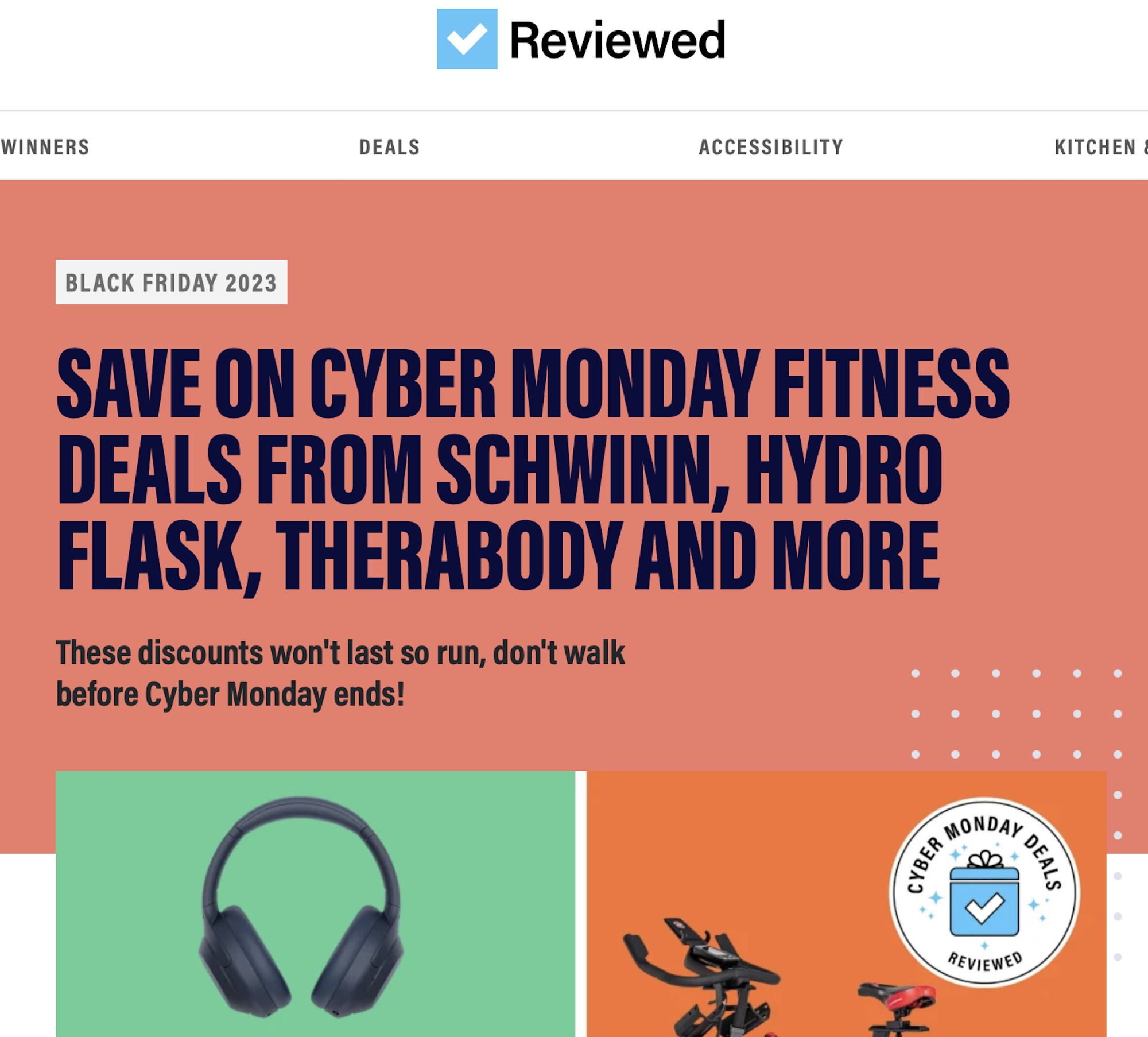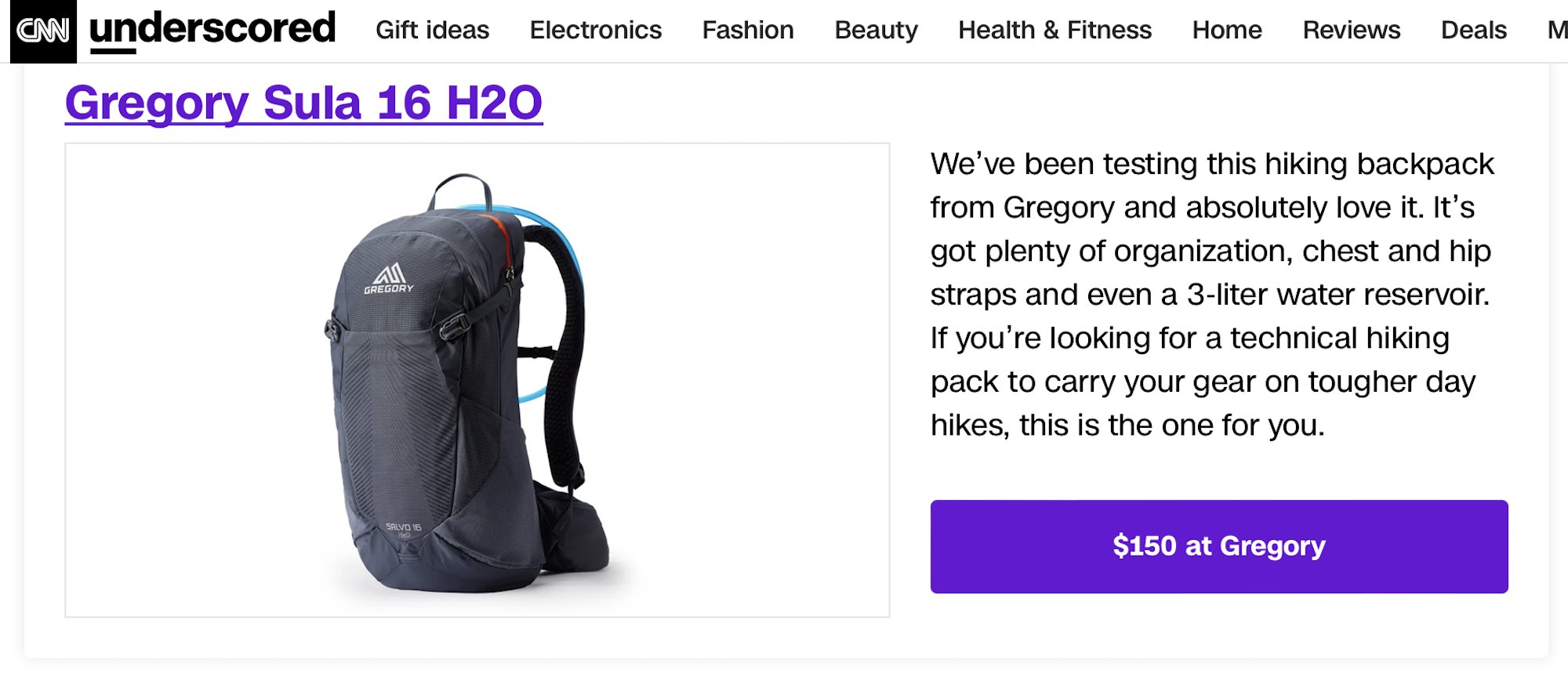I was in the middle of smashing the unsubscribe button on the pile of Black Friday/Cyber Monday e-mails that had buried my inbox when a note popped up from my wife: had I seen the news about Sports Illustrated?
To catch you up on what became the media-business scandal du jour, the once-venerated sports publication was caught attempting to pass off AI-generated content as human-written. We know this, according to the original scoop by Futurism, partly because a profile photo attached to a bio of a fake contributor was in fact for sale on a web site that sells AI-generated headshots. When Futurism asked SI’s publisher, The Arena Group, about its findings, the company promptly deleted all the articles and author bios in question.
Controversy ensued, of course. But how does that relate to Black Friday/Cyber Monday? The AI-generated stories were all for Sports Illustrated Showcase, its consumer-product review arm, and Futurism’s investigation broke at what is increasingly as crucial a time for publishers as it is retailers, at least if the blizzard of gift-guide stories is any barometer.
But one thing got less attention in the discussion: the growth of commerce content itself and how it’s slowly breaking consumer service journalism, aka product review. Why should you care what I have to say about it? In classic Wirecutter style, here’s why you should trust me: I’ve been reviewing products since 1996 as both a staff and freelance writer, and I’ve written product reviews and tech/gear coverage for Wired, Popular Mechanics, Men’s Journal, Outside, Bicycling, and The Red Bulletin. Some of it I’m quite proud of; other pieces I did for the paycheck, because that’s how product coverage and freelance journalism works. I have a journalism degree and have worked in the field my entire professional career, and I read and think a fair bit about media, especially the business, practical, and ethical challenges of the industry.
How the sausage is made (mmm, sausage)
At this point, you probably have many questions, not least of which is, “Wait, Sports Illustrated does product review?!” Yes, it does, and it’s far from alone; more than 80% of publishers do it, according to Affilimate, a software-as-a-service provider in the industry.
Commerce content is the editorial side of a kind of content partnership called affiliate marketing, and it has – like many such innovations – reasonably benign origins. You probably know the basics but, just for posterity: affiliate marketing (sometimes called affcom) is basically a sales commission for media. Said media outlet writes a review of, say, vacuums, or mountain bike tires. Each link out to a manufacturer or retailer’s purchase page for a product in the review is coded with a unique referral ID (a cookie, basically), and the media outlet gets a percent commission – usually on the order of mid single-digits, but sometimes as high as 20% – for every click-through that converts, or becomes a sale for the manufacturer or retailer. (Those cookies, btw, stick around a while – even if you buy a month later, that still counts as a conversion, which means there’s enormous incentive for publishers to get you to click.)

There’s nothing inherently malign about affcom/commerce content. In theory, it takes something that many media outlets were already doing (product review) and simply monetizes it in a closed circle: readers get qualitative reviews of and buying guides to products they’re interested in, and the purchase that some number of them might have made anyway pays for the reviews.
That premise has helped build a number of niche media businesses, and there are still some that do an excellent job with the model – DC Rainmaker is a great example right here in cycling. The problem is that, in a desperate modern media environment where no one has come up with a business model that can sustainably replace the old, ad-driven one that is rapidly dying, commerce content is one of the vanishingly few reliable revenue strategies left for publishers.
Because of that, it became a vital revenue strategy for both mainstream legacy and new-media publishers to backfill the growing crater of ad dollars that are being Hoovered up by what early era Matt Taibbi might have called the vampire squid of AdTech, namely the Meta/Google duopoly.
That is why every media outlet under the sun seems to have some sort of product-review division these days, even where they wouldn’t seem natural fits. In addition to the New York Times-acquired commerce content OG, Wirecutter, you can find product review divisions at Gannett’s USA Today, the Wall Street Journal, CNN, and, of course, Sports Illustrated and other Arena Group titles. (Arena Group, interestingly, is not SI’s owner; that’s Authentic Brands Group, which licenses the right to publish SI to Arena for a cool $15 million a year, which means Arena starts every January 1 with an eight-figure budget hole it must fill before accounting for the costs of running the title in the first place.)

But because commerce content is one of the few bright spots on the revenue side of the business and publishers lean on it hard, the original incentives are now wildly out of whack. Even when human-written, the content often strays far from the title’s original mission and focus. Do we need Sports Illustrated’s thoughts on the Shark family of vacuums? Conversely, is the business-and-money-focused Wall Street Journal’s “Buy Side” a good source of info for camping gear? Do NYC-based contributors for CNN Underscored have expertise evaluating snowsports helmets? It’s hard to say.
Commerce content has other distortive effects on product review. Publishers only earn on converted sales, so search engine optimization becomes key to driving traffic to reviews. That leads naturally to story titles like “The 10 Best Road Bikes of 2023” and from there to transparently SEO-gaming tactics such as this actual title of a product roundup: “The 10 Best Bikes You Can Buy From Cannondale.” Listen, even Joe Montgomery didn’t love the brand that much; no one shops for bikes like that.

As well, the mix of products that get reviewed can be affected by invisible-to-the-reader considerations like which affiliate platform (and therefore its brand partners) has the most competitive commission rates. And because publishers need a constant churn of fresh content to stay relevant in search and attract audiences, review categories have become atomized to absurdity: the best … beach towels? Jesus, just pick a big, thick one with a pattern you like; who fucking cares? That’s your fucking review.
Enter the digital dragon
But at least all that is written by actual people. Mostly – Gannett, the parent company of USA Today and its Reviewed division, was also recently suspected by its own staff of trying to pass off AI-generated reviews as human-written. The latest permutation of commerce content is that publishers outsource some or all of it to a third-party provider, which is called a commerce content partnership, and that’s where AI is pushing in.
Commerce content partners provide a variety of services to their publisher clients. Both Outside Interactive and Hearst (which publishes Bicycling), for instance, are current or former clients of Impact, a market maker platform connecting brands and publishers, and which provides data analytics software. Both publishers have dedicated staff and contributors who review products, many of whom are longtime cyclists and experts. But other companies in the content partnership space offer complete plug-and-play packages including the product reviews themselves. That’s what Arena was reportedly getting from an outfit called AdVon Commerce. AdVon was also the provider for Gannett’s suspicious reviews; Gannett claims the reviews were not AI-generated, but the SI-AdVon revelation would suggest skepticism of Gannett’s response.

AdVon supposedly employs humans too, although looking at its Team page, composed of rows of agreeably bland head shots of team members identified by first-name only and with no bios or social media accounts linked, you might reasonably wonder. The bio AdVon created for “Drew Ortiz,” the fake SI contributor whose headshot was for sale on an AI web site, read that Drew “has spent much of his life outdoors” and that “rarely a weekend goes by where Drew isn’t out camping, hiking, or just back on his parents’ farm.” In … Farmville, we’d guess?
AdVon’s own LinkedIn page describes the company as offering “ML/AI solutions for E Commerce.” For AdVon, humans apparently aren’t productive or cost-effective enough, and so – whether with Arena Group’s knowledge and consent or not – it supplied reviews of real products written by fake people, designed to get real people to buy real things with real money, until Futurism turned over that particular digital rock and found the code scurrying around underneath.
Killing the goose that lays golden affiliate eggs
The first wave of these converging forces – the ever-increasing, existential reliance of publishers on alternative revenue streams like commerce content; and the onrushing inevitability of Large Language Model AI content creation – is now crashing into media businesses and readers: an absolute tsunami of shit content, namely endless roundups and postage stamp-sized “reviews” that offer little to no qualitative value to readers, and which now may not even be reviews at all because how the hell does an LLM review a running shoe?
(Pedantic answer: it ingests a fuck-ton of media and consumer reviews on other sites – some of which are fake themselves, because it’s turtles all the way down – and aggregates it into a reasonable-enough facsimile of what an especially boring human writer might produce.)
There has always been a certain amount of sausage made in the product review space: personal reviewer bias and undue advertiser influence play alongside more mundane logistical realities like the mix of products available for review and the implausibly large amount of time it would take to test every road tire on the market to the extent one could authoritatively say what really are The 10 Best Road Tires for Every Cyclist.

But this? This is different. And nobody hates it more than the human writers themselves. SI’s union held a tense meeting Tuesday with the editor in chief and an Arena Group exec (who was 40 minutes late), where questions were reportedly answered unsatisfactorily, if at all. The writers know: AI will come first for the easy stuff, but it’s coming for any content that can be monetized. The rest will end up in the dumpster out back.
But the human SI staff’s collective objection is rooted in more than self-interest. Sports Illustrated was once the pre-eminent sports media publication in America: intimate profiles, riveting game coverage, and the best writers in the business were its hallmarks. Vacuum reviews? Not so much. My college sportswriting professor was a football staff writer there, and his professional experiences, sometimes as recently as that prior weekend, often formed a jumping-off point for that week’s session. Getting bylines in SI was one of my prouder moments as a freelancer.
SI has had a long fall, and Arena Group is far from the first to mis-manage it. But its demise is largely the sad result of both a shrinking media ecosystem and the shambolic mismanagement of owners and executives – often from other industries – who have long told journalists that we “don’t understand the media business.”
We don’t? Arena Group is a publicly traded company; its stock dropped by almost a third since the Futurism exposé of this experiment in ineptly destroying a brand’s reputation, although it’s recovered about half that ground since. But the damage is not confined to one greedy publisher. For whatever sales conversions its strategy produced before it was unmasked, Arena Group’s actions mostly serve to draw attention to dubious industry practices that, if continued, will eventually turn readers off to product review entirely, ultimately eroding commerce content as a viable revenue strategy for all publishers. Once you scrape the rake off your face, remind me again who doesn’t understand the media business?
Can product review be saved?
Make no mistake: there is and will continue to be good product journalism, including in cycling media. The core tech staff and contributors at outlets like Bicycling, or CyclingNews, Cycling Weekly, and Velo and Pinkbike, are committed cyclists who speak and write with authority on what they ride.
But affiliate-driven business models put editorial staffs under immense pressure to create ever more content, to review ever more stuff. That pile of Black Friday e-mails I deleted? Many were from publishers, promoting gift guides. So many gift guides. That’s the ask. If core staff can’t deliver it, management will find someone who will, and they may not look too hard at whether that someone is a real human as long as the clicks convert. And when the bad and fake sits equal alongside the good and trustworthy, that’s deeply corrosive to the entire value premise of media.
That corrosion is already well underway. The Washington Post’s Josh Tyrangiel wrote about SI’s pratfall and suggested that maybe having AI do product reviews wasn’t such a bad thing, if that freed up journalists to do “real” journalism like the Futurism scoop. I mean, I guess? But that’s a pretty low opinion of the value of service journalism like product review – Tyrangiel has basically accepted that product review is irretrievably sucky now. Part of why Escape Collective started is to get away from those forces, because we don’t think they’re good for product journalism – the people writing it or reading it. We’re not quite ready to admit defeat; there’s still a role for good product reviews, and maybe it’s even more vital now because the mis-aligned incentives are increasingly producing bad and now fake editorial.


A lot of what publishers are doing – the relentless churn of reviews; the ever more-finely sliced product categories that often don’t reflect how people really research and make buying decisions; cramming each roundup with too-short reviews of as many products as possible to maximize affiliate links; manipulative headline framing based on SEO and buyer psychology rather than simple newsworthiness – is done because revenue has quietly replaced reader service as the key goal. Again, this motive doesn’t come from the human reviewers themselves; it’s the companies that employ them. But make no mistake where the power lies or the end result: the reader, commoditized as well, is no longer the central beneficiary of the story.
To correct that means to refocus on what serves the reader and what you want and need. You’re looking to inform current and future buying decisions. To do that, you need reviews and comparisons of products chosen on their merit, not because a featured brand provides the fattest commission or is a more-favorable search term; you need reviews that are detailed enough to give you a true sense of a product’s strengths and shortcomings so you can decide if it fits your needs; and you want to read honest and thoughtful reviews, written by real people with experience and expertise.
That’s what’s being lost now. I don’t know if we can get it back; the financial incentives for the current trend are strong, and as media companies continue to cut newsroom staff, the lure of cheap AI content is hard to resist. But our hope is that people are smart enough to recognize and reward quality editorial when they see it. We kinda have to trust that; our entire business model is based on it. With every news report of a publisher pursuing ethically dubious practices for the sake of cheap, commoditized content, we confront the uneasy duality: unsure whether our approach will succeed, but convinced it is the right one for us, and hopefully for you.
What did you think of this story?

